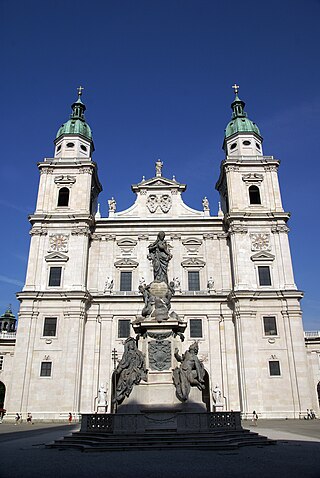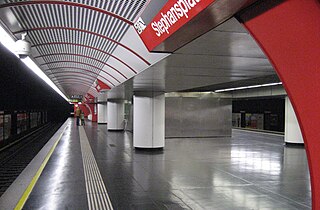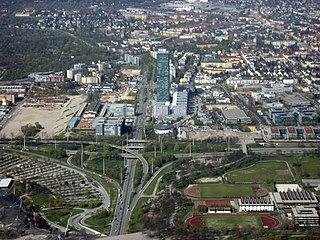History
The history of the chapel is not entirely clear. The architecture can be dated to the early 13th century. At this time, Frederick the Warlike (1230–1246), the last Duke of the House of Babenberg, was the ruler of Vienna. It has been hypothesized that the Duke, who would have liked to have established Vienna as an episcopal see, had the crypt built for St. Coloman of Stockerau, who was to be the patron of the new diocese. However, the chronicles do not mention the chapel, which has given rise to the speculation that it is the remnant of a failed project.
In the year 1307, a burial chapel of the Viennese family Chrannest is mentioned. The chapel was said to have multiple altars, one of which was dedicated to St. Vergilius of Salzburg.
In the Middle Ages, the Stephansdom was encircled by a large cemetery. A single small chapel, dedicated to St. Mary Magdalene (the Magdalenskapelle or Magdalene Chapel), existed for consecrations and requiem masses. The Virgilius Chapel lay directly underneath this chapel, and a vertical shaft connected the two buildings.
In 1782, the cemetery around the Stephansdom was closed. The Magdalene Chapel was destroyed by fire in 1781 and was not rebuilt (presumably as, without a cemetery, there was no need for a funeral chapel). The Virgilius Chapel was filled with rubble and faded into obscurity.
In 1973 the chapel was rediscovered during construction of the Vienna U-Bahn. Today there is a mosaic on the Stephansplatz showing the outlines of the Virgilius Chapel. The chapel itself has survived with hardly any damage and provides the visitor with an excellent glance into the world of the Middle Ages.

The Minoritenkirche, formally called Italienische Nationalkirche Maria Schnee, was built in French Gothic style in the Altstadt or First District of Vienna, Austria.

St. Stephen's Cathedral is the mother church of the Roman Catholic Archdiocese of Vienna and the seat of the Archbishop of Vienna, Christoph Cardinal Schönborn, OP. The current Romanesque and Gothic form of the cathedral, seen today in the Stephansplatz, was largely initiated by Duke Rudolf IV (1339–1365) and stands on the ruins of two earlier churches, the first a parish church consecrated in 1147. The most important religious building in Vienna, St. Stephen's Cathedral has borne witness to many important events in Habsburg and Austrian history and has, with its multi-coloured tile roof, become one of the city's most recognizable symbols.

The Imperial Crypt, also called the Capuchin Crypt (Kapuzinergruft), is a burial chamber beneath the Capuchin Church and monastery in Vienna, Austria. It was founded in 1618 and dedicated in 1632, and located on the Neuer Markt square of the Innere Stadt, near the Hofburg Palace. Since 1633, the Imperial Crypt serves as the principal place of entombment for the members of the House of Habsburg. The bones of 145 Habsburg royalty, plus urns containing the hearts or cremated remains of four others, are here, including 12 emperors and 18 empresses. The visible 107 metal sarcophagi and five heart urns range in style from puritan plain to exuberant rococo. Some of the dozen resident Capuchin friars continue their customary role as the guardians and caretakers of the crypt, along with their other pastoral work in Vienna. The most recent entombment was in 2011.150

Rudolf IV, also called Rudolf the Founder, was a scion of the House of Habsburg who ruled as duke of Austria, Styria and Carinthia from 1358, as well as count of Tyrol from 1363 and as the first duke of Carniola from 1364 until his death. After the Habsburgs received nothing from the decree of the Golden Bull in 1356, he gave order to draw up the "Privilegium Maius", a fake document to empower the Austrian rulers.

The Church of Mary Magdalene is an Orthodox Christian church located on the Mount of Olives, directly across the Kidron Valley from the Temple Mount and near the Garden of Gethsemane in Jerusalem.

The Innere Stadt is the 1st municipal district of Vienna located in the center of the Austrian capital. The Innere Stadt is the old town of Vienna. Until the city boundaries were expanded in 1850, the Innere Stadt was congruent with the city of Vienna. Traditionally it was divided into four quarters, which were designated after important town gates: Stubenviertel (northeast), Kärntner Viertel (southeast), Widmerviertel (southwest), Schottenviertel (northwest).

St. Marx Cemetery is a cemetery in the Landstraße district of Vienna, used from 1784 until 1874. It contains the unmarked grave of the famous composer Wolfgang Amadeus Mozart.

The Graben is one of the most famous squares in Vienna's first district, the city center. It begins at Stock-im-Eisen-Platz next to the Palais Equitable, and ends at the junction of Kohlmarkt and Tuchlauben. Another street in the first district is called Tiefer Graben. It is crossed by Wipplinger Straße by means of the Hohe Brücke, a bridge about 10 meters (33 ft) above street level.

Salzburg Cathedral is the seventeenth-century Baroque cathedral of the Roman Catholic Archdiocese of Salzburg in the city of Salzburg, Austria, dedicated to Saint Rupert and Saint Vergilius. Saint Rupert founded the church in 774 on the remnants of a Roman town, and the cathedral was rebuilt in 1181 after a fire. In the seventeenth century, the cathedral was completely rebuilt in the Baroque style under Prince-Bishop Wolf Dietrich von Raitenau to its present appearance. Salzburg Cathedral still contains the baptismal font in which composer Wolfgang Amadeus Mozart was baptized.

St. Rupert's Church is a Romanesque church in Vienna, Austria. Traditionally considered to be the oldest church in the city, St. Rupert's Church is dedicated to Saint Rupert of Salzburg, patron saint of the salt merchants of Vienna. The church is located in one of the oldest parts of the city, the section of the Roman Vindobona.

Virgil, also spelled Vergil, Vergilius, Virgilius, Feirgil or Fearghal, was an Irish churchman and early astronomer. He left Ireland around 745, intending to visit the Holy Land; but, like many of his countrymen, he settled in Francia. Virgil served as abbot of Aghaboe, bishop of Ossory and later bishop of Salzburg. He was called "the Apostle of Carinthia" and "the geometer".

The Ducal Crypt is a burial chamber beneath the chancel of Stephansdom in Vienna, Austria. It holds 78 containers with the bodies, hearts, or viscera of 72 members of the House of Habsburg.

Wien Praterstern is one of Vienna's main railway stations, used by 35,000 people daily. It is located on the roundabout Praterstern in Leopoldstadt, in the north of the city. Vienna's two most recognisable structures, the Wiener Riesenrad and the Stephansdom (cathedral), are both visible from the platforms. Underneath the station is the Praterstern U-Bahn station, which is on U1 and U2 of the Vienna U-Bahn.

The Stephansplatz is a square at the geographical centre of Vienna. It is named after its most prominent building, the Stephansdom, Vienna's cathedral and one of the tallest churches in the world. Before the 20th century, a row of houses separated Stephansplatz from Stock-im-Eisen-Platz, but since their destruction, the name Stephansplatz started to be used for the wider area covering both. To the west and south, respectively, run the exclusive shopping streets Graben and Kärntner Straße. Opposite the Stephansdom is the Haas-Haus, a piece of striking modern architecture by Hans Hollein. Although public opinion was originally skeptical about the combination of the mediaeval cathedral and the glass and steel building, it is now considered an example of how old and new architecture can mix harmoniously .

Wakapuaka Cemetery is a cemetery located in Brooklands, Nelson, New Zealand. "Wakapuaka" is Māori for "heaps of aka leaves".

Stephansplatz is an important destination and interchange station in the Vienna U-Bahn system. It is located under the Stephansplatz and is served by lines U1 and U3. It is located in the Innere Stadt district.

The Palais Equitable is a mansion in Stock-im-Eisen-Platz in the Innere Stadt of Vienna, Austria, that was built in the 19th century for The Equitable Life Assurance Society of the United States and that incorporates the Stock im Eisen on one corner.

The Vienna Museum is a group of museums in Vienna consisting of the museums of the history of the city. In addition to the main building in Karlsplatz and the Hermesvilla, the group includes numerous specialised museums, musicians' residences and archaeological excavations.

Moosach[ˈmoːsax] is the 10th northwestern district of Munich, Bavaria, Germany. It is sectioned in the urban districts Hartmannshofen, Pressestadt and Borstei.

The Linienwall was an outer line of fortifications for the city of Vienna, Austria, which lay between the city's suburbs and outlying villages. Constructed in 1704, it was razed in 1894 to make way for the Vienna Beltway.




















